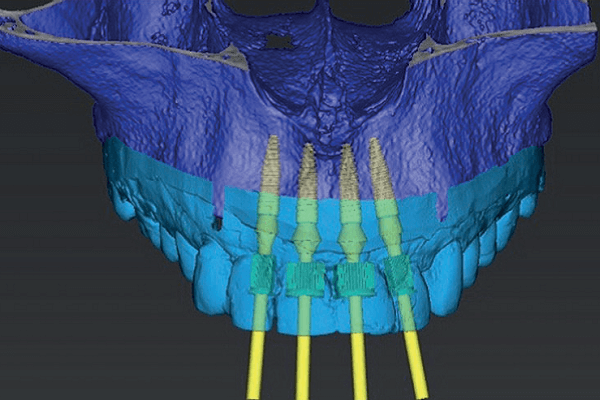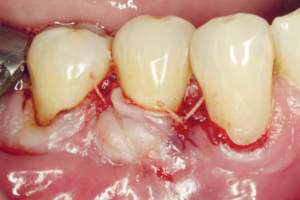RESUMO
A introdução da Odontologia digital redefiniu os conceitos de tratamento na Odontologia de implantes. A colocação de implantes guiada por computador tornou-se uma prática usual em busca do melhor posicionamento tridimensional. Esses avanços nas opções e modalidades de tratamento levaram a uma mudança de paradigma no fluxo de trabalho dos tratamentos cirúrgicos e restauradores. Este relato de caso apresentou um protocolo personalizado de tratamento imediato, que envolve a utilização de guia cirúrgico na região anterior de maxila confecionado após planejamento virtual prévio. Com o intuito de preservar ao máximo as estruturas do tecido mole, foi escolhida a provisionalização imediata utilizando as próprias coroas dos elementos após exodontia como parâmetro de tamanho de colo e perfil de emergência. Essa técnica facilita a obtenção de provisórios com boa qualidade estética e funcional, uma vez que a forma, a cor e o tamanho dos dentes são mantidos e corrigidos no seu melhor posicionamento na arcada. Este protocolo de tratamento também descreve um fluxo de trabalho digital e convencional integrado para reabilitações protéticas fixas suportadas por implantes, a fim de proporcionar melhor previsibilidade, menos complicações e menor invasividade.
Palavras-chave – Arcada parcialmente edêntula; Cirurgia assistida por computador; Implantação dentária endóssea; Prótese dentária fixada por implante; Implantes.
ABSTRACT
The introduction of digital dentistry has redefined the concepts of dental implant treatment. A computer-guided implant placement became a common practice in the search for better three-dimensional positioning. These advances in treatment options have led to a paradigm shift in the workflow of surgical and restorative procedures. This case report presents a personalized protocol for immediate treatment, which involves the use of a surgical guide on the anterior maxillary region made after previous virtual planning. In order to preserve tissue structures as much as possible, the provisional immediate application was chosen as forbidden the application of crowns of the elements after extraction as parameters of neck size and loss profile. This technique facilitates the use of provisionals with good aesthetic and functional quality since the shape, color, and size of the teeth are maintained and corrected in their best position in the arch. This treatment protocol also describes a digital and conventional workflow for prosthetic rehabilitations fixed by implants, in order to provide better predictability, fewer complications, and less invasiveness.
Key words – Partially edentulous arch; Computer assisted surgery; Endosseous dental implantation; Implant-fixed dental prosthesis; Dental implants.
Referências
- Schwarz MS, Rothman SL, Rhodes ML, Chafetz N. Computed tomography: part II. Preoperative assessment of the maxilla for endosseous implant surgery. Int J Oral Maxillofac Implants 1987;2(3):143-8.
- Schwarz MS, Rothman SL, Rhodes ML, Chafetz N. Computed tomography: part I. Preoperative assessment of the mandible for endosseous implant surgery. Int J Oral Maxillofac Implants 1987;2(3):137-41.
- Bover-Ramos F, Viña-Almunia J, Cervera-Ballester J, Peñarrocha-Diago M, García-Mira B. Accuracy of implant placement with computer-guided surgery: a systematic review and meta-analysis comparing cadaver, clinical, and in vitro studies. Int J Oral Maxillofac Implants 2018;33(1):101-15.
- Cristache CM, Gurbanescu S. Accuracy evaluation of a stereolithographic surgical template for dental implant insertion using 3D superimposition protocol. Int J Dent 2017;2017:4292081.
- van Steenberghe D, Glauser R, Blombäck U, Andersson M, Schutyser F, Pettersson A et al. A computed tomographic scan-derived customized surgical template and fixed prosthesis for flapless surgery and immediate loading of implants in fully edentulous maxillae: a prospective multicenter study. Clin Implant Dent Relat Res 2005;7(suppl.1):S111-20.
- Weiss R 2nd, Read-Fuller A. Cone beam computed tomography in oral and maxillofacial surgery: an evidence-based review. Dent J (Basel) 2019;7(2):E52.
- Verstreken K, Van Cleynenbreugel J, Marchal G, Naert I, Suetens P, van Steenberghe D. Computer-assisted planning of oral implant surgery: a three-dimensional approach. Int J Oral Maxillofac Implants 1996;11(6):806-10.
- Vercruyssen M, Laleman I, Jacobs R, Quirynen M. Computer-supported implant planning and guided surgery: a narrative review. Clin Oral Implants Res 2015;26(suppl.11):69-76.
- Schneider D, Marquardt P, Zwahlen M, Jung RE. A systematic review on the accuracy and the clinical outcome of computer-guided template-based implant dentistry. Clin Oral Implants Res 2009;20(suppl.4):73-86.
- D’haese J, Ackhurst J, Wismeijer D, De Bruyn H, Tahmaseb A. Current state of the art of computer-guided implant surgery. Periodontol 2000 2017;73(1):121-33.
- Cordaro L, Torsello F, Ribeiro CA. Transition from a failing dentition to a removable implant-supported prosthesis: a staged approach. Quintessence Int 2010;41(5):371-8.
- Drew HJ, Alnassar T, Gluck K, Rynar JE. Considerations for a staged approach in implant dentistry. Quintessence Int 2012;43(1):29-36.
- el Attar MS, el Shazly D, Osman S, el Domiati S, Salloum MG. Study of the effect of using mini-transitional implants as temporary abutments in implant overdenture cases. Implant Dent 1999;8(2):152-8.
- Gallucci GO, Finelle G, Papadimitriou DE, Lee SJ. Innovative approach to computer-guided surgery and fixed provisionalization assisted by screw-retained transitional implants. Int J Oral Maxillofac Implants 2015;30(2):403-10.
- Jivraj S, Reshad M, Chee WW. Transitioning patients from teeth to implants utilizing fixed restorations. J Calif Dent Assoc 2008;36(8):599-606.
- Petrungaro PS, Windmiller N. Using transitional implants during the healing phase of implant reconstruction. Gen Dent 2001;49(1):46-51.
- Margeas RC. Predictable periimplant gingival esthetics: use of the natural tooth as a provisional following implant placement. J Esthet Restor Dent 2006;18(1):5-12.
- González-Martín O, Lee E, Weisgold A, Veltri M, Su H. Contour management of implant restorations for optimal emergence profiles: guidelines for immediate and delayed provisional restorations. Int J Periodontics Restorative Dent 2020;40(1):61-70.
- Al Mortadi N, Eggbeer D, Lewis J, Williams RJ. CAD/CAM/AM applications in the manufacture of dental appliances. Am J Orthod Dentofacial Orthop 2012;142(5):727-33.
- Davidowitz G, Kotick PG. The use of CAD/CAM in dentistry. Dent Clin North Am 2011;55(3):559-70.
- Hämmerle CH, Stone P, Jung RE, Kapos T, Brodala N. Consensus statements and recommended clinical procedures regarding computer-assisted implant dentistry. Int J Oral Maxillofac Implants 2009;24(suppl.126-31).
- Youk SY, Lee JH, Park JM, Heo SJ, Roh HK, Park EJ et al. A survey of the satisfaction of patients who have undergone implant surgery with and without employing a computer-guided implant surgical template. J Adv Prosthodont 2014;6(5):395-405.
- Wood DL, Hoag PM, Donnenfeld OW, Rosenfeld LD. Alveolar crest reduction following full and partial thickness flaps. J Periodontol 1972;43(3):141-4.
- Nobuto T, Suwa F, Kono T, Taguchi Y, Takahashi T, Kanemura N et al. Microvascular response in the periosteum following mucoperiosteal flap surgery in dogs: angiogenesis and bone resorption and formation. J Periodontol 2005;76(8):1346-53.
- Maier FM. Initial crestal bone loss after implant placement with flapped or flapless surgery – a prospective cohort study. Int J Oral Maxillofac Implants 2016;31(4):876-83.
- Cairo F, Pagliaro U, Nieri M. Soft tissue management at implant sites. J Clin Periodontol 2008;35(suppl.8):163-7.
- Jeong SM, Choi BH, Li J, Kim HS, Ko CY, Jung JH et al. Flapless implant surgery: an experimental study. Oral Surg Oral Med Oral Pathol Oral Radiol Endod 2007;104(1):24-8.
- Brodala N. Flapless surgery and its effect on dental implant outcomes. Int J Oral Maxillofac Implants 2009;24(suppl.):118-25.
- Arisan V, Karabuda CZ, Ozdemir T. Implant surgery using bone- and mucosa-supported stereolithographic guides in totally edentulous jaws: surgical and post-operative outcomes of computer-aided vs. standard techniques. Clin Oral Implants Res 2010;21(9):980-8.
- Laederach V, Mukaddam K, Payer M, Filippi A, Kühl S. Deviations of different systems for guided implant surgery. Clin Oral Implants Res 2017;28(9):1147-51.
- Bover-Ramos F, Vina-Almunia J, Cervera-Ballester J, Penarrocha-Diago M, Garcia-Mira B. Accuracy of implant placement with computer-guided surgery: a systematic review and meta-analysis comparing cadaver, clinical, and in vitro studies. Int J Oral Maxillofac Implants 2018;33(1):101-15.
- Kan JYK, Rungcharassaeng K, Deflorian M, Weinstein T, Wang HL, Testori T. Immediate implant placement and provisionalization of maxillary anterior single implants. Periodontol 2000 2018;77(1):197-212.





